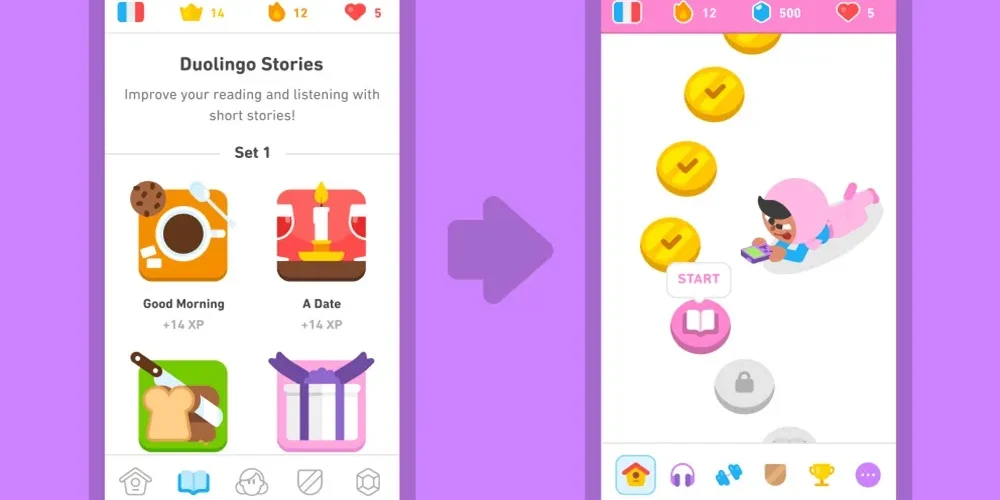Duolingo has long been a driving language-learning app, advertising available, free, and fun ways for individuals to learn modern dialects. Be that as it may, over the a long time, Duolingo has experienced critical overhauls and changes, advancing from its unique plan and structure to something more advanced. For numerous long-time clients, the move from the old Duolingo to the unused Duolingo has started wrangles about. In this article, we will investigate both the old Duolingo and unused Duolingo, looking at their highlights, benefits, and downsides, and eventually choosing which form is superior for dialect learners today.
1. Presentation to Duolingo
Duolingo, established in 2011 by Luis von Ahn and Severin Programmer, begun as a progressive device for dialect learning. The concept was straightforward: make an app that offers free dialect courses, utilizing gamified components to lock in clients. It rapidly became a prevalent asset, advertising lessons in over 30 languages.
The unique plan of old Duolingo was moderate, with a clear accentuation on perusing, deciphering, and memorizing lexicon. As the app advanced, Duolingo included more highlights, made strides its client interface, and extended its offerings with a bigger center on tuning in, talking, and language structure aptitudes. Whereas these overhauls have improved the app’s capabilities, numerous clients still think back around the effortlessness of the old Duolingo.
In addition, modern Duolingo grasps a more cleaned and present day approach, joining unused highlights like “Duolingo Plus” memberships, a patched up client interface, and personalized learning plans. With the advancement of Duolingo came both commend for the modern highlights and feedback from clients who favored the prior form. So, how does old Duolingo compare to modern Duolingo? Let’s take a more profound jump into both adaptations and compare their differences.
2. The Client Interface – Ancient vs. New
The old Duolingo interface was direct, advertising straightforward text-based lessons and prompts that clients might effortlessly explore. The primary center of the unique app was its lessons, which were planned to be fast, intuitively, and simple to take after. The interface was exceptionally moderate, including straightforward buttons and an essential format. For clients who needed to center simply on dialect learning, this no-frills approach was exceptionally appealing.
However, as the app developed, Duolingo had to address the require for a more outwardly engaging plan. The modern Duolingo brought a noteworthy update in terms of client encounter. The interface got to be more colorful, with fun outlines and a lively plan. The app presented a “tree” structure, where clients seem to advance through levels of trouble. Along with visual improvements, Duolingo presented highlights like personalized objectives, motivational identifications, and a redone advance tracker.
These changes made the unused Duolingo more locks in and fun for clients who appreciate gamified components, but they moreover made the app a bit more complex. Whereas the old Duolingo was exceptionally basic, a few clients found the more up to date plan a bit overpowering, particularly when learning dialects to begin with.
Key Differences:
- Old Duolingo: Basic, clear, moderate interface.
- New Duolingo: Colorful, gamified, and more feature-rich interface with advance trackers and personalized goals.
3. The Learning Involvement – old Duolingo vs. Unused Duolingo
At its center, Duolingo has continuously been almost making dialect learning fun. In the old Duolingo, the learning involvement centered basically on monotonous works out, counting interpreting expressions and completing multiple-choice questions. This strategy permitted learners to hone lexicon, language structure, and sentence structure in a way that was both challenging and productive. The ancient version’s straightforwardness implied that clients seem get through lessons rapidly without distractions.
As the app advanced, unused Duolingo started to include more complex components to the learning involvement. One of the most eminent changes is the presentation of discourse acknowledgment and tuning in works out, which permit learners to hone their talking and tuning in aptitudes in a more energetic way. Moreover, unused Duolingo offers personalized learning ways, where the app adjusts to the user’s ability level and tailors lessons accordingly.
The old Duolingo was more approximately memorization and drills, whereas unused Duolingo consolidates versatile learning innovation that makes the lessons feel more intuitively and personalized. This has been a huge additionally for clients who need a more individualized encounter. In any case, a few long-time clients feel that the unused framework centers as well much on gamification and less on genuine language structure practice.
Key Differences:
- Old Duolingo: Centered on memorization, interpretation, and basic exercises.
- New Duolingo: Highlights discourse acknowledgment, versatile learning, and tuning in exercises.
4. Gamification – old Duolingo vs. Unused Duolingo
Gamification has become a central highlight of modern Duolingo, with the app presenting different rewards, streaks, and competitions to keep learners propelled. The old Duolingo included a few gamified components, like winning focuses and leveling up, but these highlights were negligible compared to what’s accessible today.
In the unused Duolingo, clients can collect identifications, gain crowns for completing levels, and get notices to empower them to keep up with their lessons. One of the most locks in highlights of the unused form is the “leaderboard,” where clients can compete with companions or worldwide clients. This includes a competitive component to dialect learning, which a few individuals discover spurring whereas others feel diverted by the competition.
Another major move is the presentation of Duolingo Additionally, a premium membership benefit that expels advertisements, offers offline get to, and gives extra highlights such as boundless hearts (permitting you to make botches without losing advance). The old Duolingo was totally free with no paid membership alternatives, which numerous clients acknowledged for its accessibility.
Key Differences:
- Old Duolingo: Negligible gamification with fundamental point frameworks and leveling up.
- New Duolingo: Progressed gamification with identifications, streaks, leaderboards, and premium membership services.
5. Substance and Course Offerings – Ancient vs. Modern Duolingo
In terms of dialect offerings, the old Duolingo begun with a littler choice of dialects and essentially centered on major dialects like Spanish, French, and German. Whereas the courses were compelling, the number of dialects accessible was constrained, and the course substance was moderately straightforward.
New Duolingo has endlessly extended its dialect offerings, with over 30 dialects presently accessible, counting dialects that are not broadly talked, such as Welsh, Hawaiian, and indeed anecdotal dialects like Klingon. The app moreover offers more in-depth lessons on language structure, sentence structure, and commonsense dialect utilization. Also, unused courses have been made in collaboration with phonetic specialists to guarantee that the substance is significant and accurate.
As the unused Duolingo proceeds to advance, extra highlights such as language-specific occasions and community gatherings permit learners to interface with others. These overhauls have made Duolingo a more well-rounded stage for learning a modern dialect, particularly for those interested in specialty dialects or social contexts.
Key Differences:
- Old Duolingo: Restricted dialect offerings with a center on essential dialect skills.
- New Duolingo: Extended dialect offerings, counting specialty dialects, linguistic use lessons, and community engagement.
6. Duolingo Additionally: The Paid Adaptation – Ancient vs. New
Duolingo Also is a moderately modern include that offers extra benefits to clients who are willing to pay for the premium form of the app. With Duolingo Furthermore, clients can appreciate highlights like offline get to to lessons, an ad-free involvement, and more hearts (permitting clients to make botches without punishment). In differentiate, the old Duolingo was totally free to utilize and did not offer any paid premium features.
For numerous clients, the presentation of Duolingo Additionally has been a positive alter, as it permits for a more personalized and adaptable learning encounter. In any case, a few clients feel that the free form is still exceptionally successful, and they see the premium highlights as unnecessary.
Key Differences:
- Old Duolingo: Totally free with no premium version.
- New Duolingo: Offers Duolingo Also, a paid form with additional highlights like offline get to, ad-free learning, and boundless hearts.
7. The Social Perspective – old Duolingo vs. Unused Duolingo
Another eminent alter between the old Duolingo and modern Duolingo is the expanded center on social interaction. Modern Duolingo presents highlights like leaderboards, challenges, and the capacity to take after other clients, which cultivates a sense of community and competition. These highlights are planned to keep clients persuaded and engaged.
In differentiate, old Duolingo was more single. Whereas you seem track your advance, there was restricted interaction with other learners. For a few, this was a more centered approach to learning, whereas others found it separating and favored the social components presented in the more up to date version.
Key Differences:
- Old Duolingo: Restricted social interaction, centered exclusively on learning.
- New Duolingo: Social highlights like leaderboards, challenges, and the capacity to associated with other learners.
8. Which One is Better?
Ultimately, whether old Duolingo or modern Duolingo is superior depends on individual inclination. If you lean toward a basic, no-frills approach to dialect learning, at that point the old Duolingo may be a way better choice for you. In any case, if you appreciate a more energetic, gamified, and socially intelligently learning involvement, at that point the modern Duolingo is likely to be more engaging.
The unused Duolingo offers a more cutting edge, cleaned learning involvement, total with personalized highlights, extra substance, and gamification components. On the other hand, the old Duolingo advertised a streamlined, direct learning prepare, which a few clients still lean toward for its simplicity.
Conclusion
Both forms have their merits, and it eventually comes down to what you esteem most in a language-learning app. Whether you select old Duolingo or modern Duolingo, both adaptations have demonstrated to be compelling devices for learners, and Duolingo proceeds to be one of the most well known and open dialect learning stages accessible nowadays.





